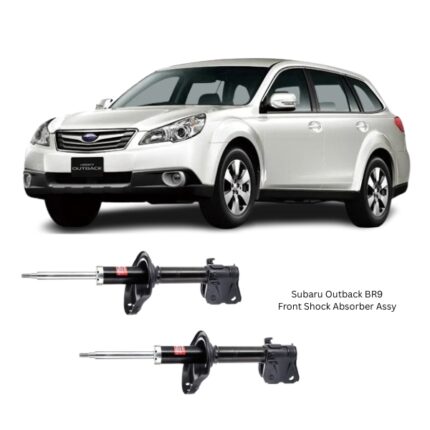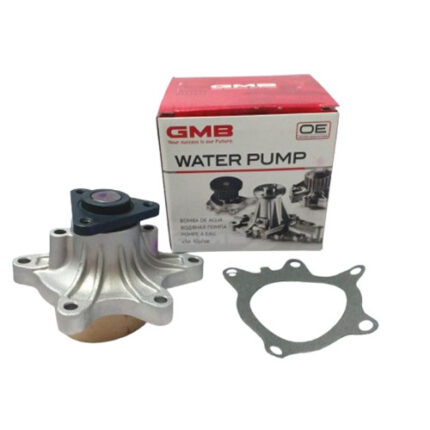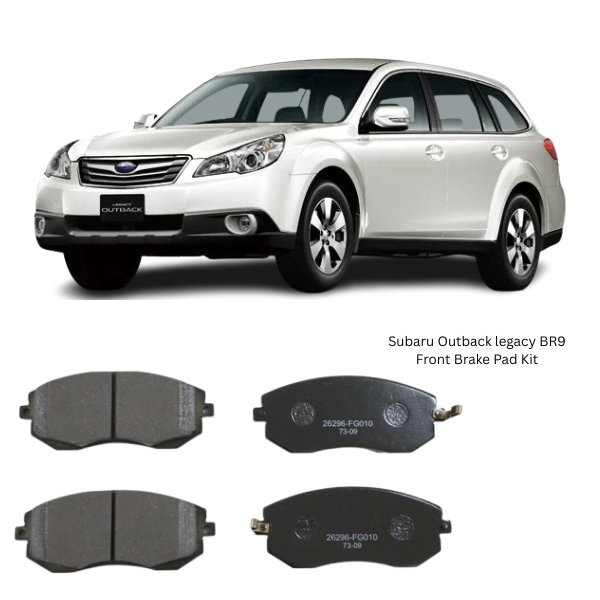Get Subaru Outback legacy BR9 Front Brake Pad Kit D7055 in Kenya
The Front Brake Pad Kit is a critical component of a vehicle’s braking system. Positioned in the front disc brakes, brake pads play a key role in providing safe, reliable stopping power by creating the friction needed to slow down or stop the vehicle. As the front brakes bear the majority of braking force, maintaining the condition of the front brake pads is essential for road safety, optimal vehicle control, and overall brake system performance.
A front brake pad kit typically includes a set of brake pads for both front wheels, and may also contain necessary accessories such as anti-rattle clips, shims, or wear indicators depending on the design. Whether used for routine maintenance, performance enhancement, or restoring braking performance, the kit ensures that the braking system operates at peak efficiency.
Function and Operation
The main function of brake pads is to convert kinetic energy into heat through friction. When the brake pedal is pressed, hydraulic pressure from the master cylinder forces the brake calipers to squeeze the pads against the brake rotors. This contact generates friction, which slows the rotation of the wheels and brings the vehicle to a stop.
The front brakes are typically more robust and wear faster than the rear due to the forward weight transfer during braking. This is why the Front Brake Pad Kit is a key component in regular brake servicing and safety assurance.
Construction and Materials
Modern brake pads are engineered using advanced friction materials that offer the right balance between stopping power, noise control, durability, and heat dissipation. A standard front brake pad includes several layers:
1. Friction Material Layer:
This is the contact surface that presses against the brake rotor. Common material types include:
-
Semi-Metallic: Contains a blend of metal shavings and synthetic materials. Durable and good at heat dissipation.
-
Ceramic: Offers quieter braking, less dust, and stable performance over a wide temperature range.
-
Organic (Non-Asbestos Organic – NAO): Made from resins, rubber, glass, and Kevlar. Quieter and gentler on rotors, but generally less durable.
2. Backing Plate:
A rigid steel plate that supports the friction material and transfers force from the caliper piston to the brake pad surface.
3. Shim or Insulator:
Often included to reduce noise and vibration. Some kits may include multi-layer shims for enhanced sound damping.
4. Adhesive Layer:
Bonds the friction material to the backing plate using high-temperature bonding agents.
High-quality kits are engineered to exact tolerances, ensuring precise fitment and consistent braking performance under various driving conditions.
Contents of a Front Brake Pad Kit
A typical front brake pad kit may include:
-
Two inner and two outer brake pads (for both front wheels)
-
Anti-rattle clips or hardware (if applicable)
-
Wear indicators or sensors (on some models)
-
Backing shims or insulators
-
Brake grease or anti-squeal compound (in some aftermarket kits)
This complete package ensures that all components needed for a proper, noise-free installation are included.
Performance and Safety Benefits
Installing a new Front Brake Pad Kit restores or enhances braking performance, delivering multiple advantages:
-
Reliable Stopping Power:
New pads provide consistent and responsive braking under various conditions, including emergency stops. -
Improved Brake Feel:
Reduces pedal softness or sponginess often caused by worn pads. -
Reduced Noise and Vibration:
Modern pads come with shims and vibration-damping technology to minimize squealing and grinding noises. -
Enhanced Safety:
Ensures proper stopping distance, especially during high-speed or wet braking. -
Minimized Rotor Wear:
Quality pads prevent premature rotor scoring or warping by distributing pressure evenly. -
Dust Reduction:
Ceramic and low-metallic pads generate less brake dust, helping keep wheels cleaner.
These benefits make the front brake pad kit a valuable component in both routine maintenance and performance upgrades.
Symptoms of Worn or Failing Front Brake Pads
Monitoring the condition of front brake pads is essential for road safety. Common signs of wear include:
-
Squealing or Squeaking Noise:
Often a result of wear indicators contacting the rotor, signaling that the pads need replacement. -
Grinding Sound:
Indicates metal-to-metal contact due to completely worn-out pads, which can damage rotors. -
Reduced Braking Efficiency:
Longer stopping distances or brake fade during repeated use. -
Brake Warning Light:
Some systems use electronic wear sensors to alert the driver when pad material is low. -
Uneven Braking or Pulling:
May occur if one pad is more worn than the other, leading to imbalance. -
Visual Inspection:
Less than 3mm of visible friction material on the pad usually means it’s time for replacement.
Addressing these signs early helps avoid more extensive repairs and ensures consistent brake performance.
Installation Overview
Replacing a Front Brake Pad Kit is a moderately technical task that requires mechanical tools and a good understanding of the braking system.
Typical Installation Steps:
-
Lift the Vehicle Safely:
Secure the front end using a jack and axle stands or a lift. -
Remove the Front Wheels:
Provides clear access to the brake assemblies. -
Detach the Caliper:
Remove caliper bolts and carefully slide the caliper off the rotor. Support it to prevent strain on the brake hose. -
Remove the Old Pads and Hardware:
Inspect the old pads for wear patterns. Remove any clips or shims. -
Install New Pads and Hardware:
Apply brake grease to contact points. Install new clips, shims, and pads. -
Reinstall the Caliper:
Compress the caliper piston if needed. Refit and torque the bolts. -
Reinstall Wheels and Lower the Vehicle.
-
Test Brakes:
Before driving, pump the brake pedal several times to ensure pad seating and hydraulic pressure.
Proper bedding-in of new pads is recommended to optimize performance and lifespan. This usually involves a series of moderate stops to condition the friction surfaces.
Maintenance Tips for Longevity
To ensure maximum life and performance from your new brake pads:
-
Check Pads Regularly:
Inspect every 10,000–15,000 kilometers or during oil changes. -
Avoid Aggressive Braking When Cold:
Heat-cycling the pads gently helps them last longer. -
Clean Calipers and Hardware During Install:
Prevents buildup of brake dust or rust that can affect pad movement. -
Avoid Mixing Pad Types:
Use matching sets to maintain balanced braking performance. -
Monitor Rotor Condition:
Worn or warped rotors can damage new pads and reduce stopping efficiency.
Follow us on Facebook for more parts.




